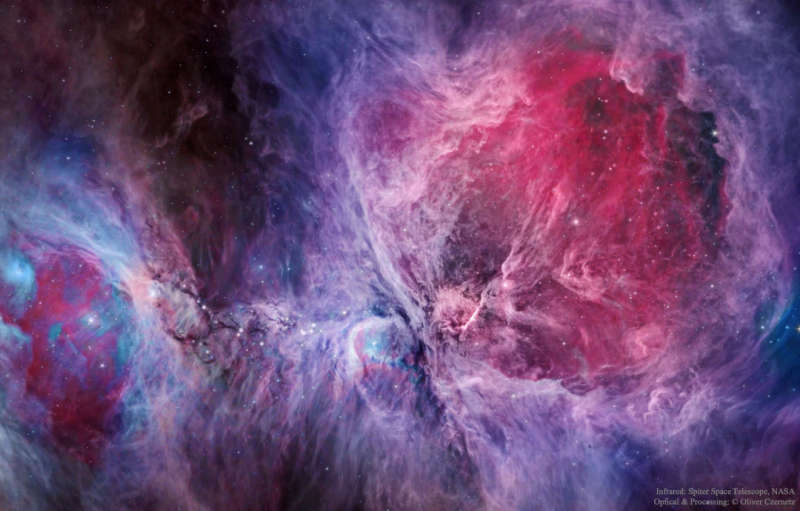Credit & Copyright: Infrared: NASA,
Spitzer Space Telescope;
Visible:
Oliver Czernetz,
Siding Spring Obs.
Explanation:
The Great Nebula in Orion is a colorful place.
Visible to the unaided eye, it appears as a small
fuzzy patch in the constellation of Orion.
Long exposure,
multi-wavelength images like this, however, show the
Orion Nebula to be a busy neighborhood of young stars, hot gas, and dark
dust.
This digital composite
features not only three colors of
visible light but four colors of
infrared light taken by
NASA's orbiting
Spitzer Space Telescope as well.
The power behind much of the
Orion Nebula
(M42) is the
Trapezium -
four of the brightest stars in the nebula.
Many of the
filamentary structures visible are actually
shock waves - fronts
where fast moving material encounters slow moving gas.
The Orion Nebula spans about 40 light years and is
located about 1500
light years away in the same
spiral arm of
our Galaxy as the
Sun.
Follow APOD on:
Facebook,
Google Plus,
Instagram, or
Twitter
1999 2000 2001 2002 2003 2004 2005 2006 2007 2008 2009 2010 2011 2012 2013 2014 2015 2016 2017 2018 2019 2020 2021 2022 2023 2024 2025 |
Январь Февраль Март Апрель Май Июнь Июль Август Сентябрь Октябрь Ноябрь Декабрь |
NASA Web Site Statements, Warnings, and Disclaimers
NASA Official: Jay Norris. Specific rights apply.
A service of: LHEA at NASA / GSFC
& Michigan Tech. U.
|
Публикации с ключевыми словами:
M 42 - Orion Nebula - Туманность Ориона
Публикации со словами: M 42 - Orion Nebula - Туманность Ориона | |
См. также:
Все публикации на ту же тему >> | |
